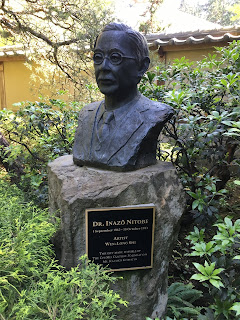Day 7
This week has started off with such great weather... maybe a little bit too hot for being outside all day but the hose helps a lot. Thankfully, today was a little cooler than yesterday with a beautiful breeze. We also got a new addition to the CFE Orchard Garden team... Welcome Naomi!
We started day 7 by meeting up at the Orchard Garden in the morning and then had a mini garden tour while we walked across campus to the Nitobe Memorial Garden. I was quite surprised at how many mini gardens there are on campus. The first garden we stopped at was the biggest and was one of the neighbourhood gardens for the community. This garden was found off in the residential part of campus tucked behind condos and a tiny forested area.
 |
| Mini Apple Tree Orchard |
 |
| Apple trees and garlic planted together |
After, we were given a little background on the Orchard Garden. The garden used to be situated where huge while buildings (pictured below) now reside which is located near the Agora Cafe. It was interesting to learn more of the history of the Orchard Garden, where it was first located and all the changes that have occurred in the last ten years of being established.
We finally arrived at the Nitobe Memorial Garden to start our tour with Tsubasa. He was an excellent guide and was very knowledgable as he taught us about the history of Japanese gardens. First, Tsubasa taught us about what Japanese Gardens are used for. They are very different from what we know as gardens and school gardens. Japanese gardens are not used for growing edible plants but rather used more for art and safety. We were told that there are three main kinds of Japanese gardens: Karesansui (rock, dry, zen garden), Tsukiyama (hill and pond garden) and Chaniwa (tea garden).

Nitobe Memorial Garden is a tea and stroll garden. We learned about its history and what the garden symbolizes. The garden was named after Dr. Inazo Nitobe and was gifted to the UBC campus after his death.
We learned that the garden symbolizes the family figure as well as the life journey. The natural elements represent meanings and stories. For example, the waterfall symbolized the strong father presence in the family while the stream represents a calming mother presence. There were two paths that represent some journeys in life such as a difficult path and an easy path. Even the bridges represented different things. There were three bridges and they all had different meanings. There was the bridge of cross cultures, there was the early marriage bridge and the teenage bridge.
This bridge is in a shape of a zigzag because it is believed that evil spirits can only move in linear lines. This zigzag shape protects you.

This is the house were the tea ceremonies happen at Nitobe Garden. We were not allowed inside but I am curious to know what happens at a tea ceremony.
We finally arrived at the Nitobe Memorial Garden to start our tour with Tsubasa. He was an excellent guide and was very knowledgable as he taught us about the history of Japanese gardens. First, Tsubasa taught us about what Japanese Gardens are used for. They are very different from what we know as gardens and school gardens. Japanese gardens are not used for growing edible plants but rather used more for art and safety. We were told that there are three main kinds of Japanese gardens: Karesansui (rock, dry, zen garden), Tsukiyama (hill and pond garden) and Chaniwa (tea garden).

Nitobe Memorial Garden is a tea and stroll garden. We learned about its history and what the garden symbolizes. The garden was named after Dr. Inazo Nitobe and was gifted to the UBC campus after his death.
We learned that the garden symbolizes the family figure as well as the life journey. The natural elements represent meanings and stories. For example, the waterfall symbolized the strong father presence in the family while the stream represents a calming mother presence. There were two paths that represent some journeys in life such as a difficult path and an easy path. Even the bridges represented different things. There were three bridges and they all had different meanings. There was the bridge of cross cultures, there was the early marriage bridge and the teenage bridge.
This bridge is in a shape of a zigzag because it is believed that evil spirits can only move in linear lines. This zigzag shape protects you.

I would highly suggest that everyone should visit a Japanese garden just to experience the serenity of it! It is absolutely beautiful.
Our afternoon was spent working hard. It is very pleasant being able to get our hands dirty in the soil and tend to the garden.
 |
| We watered the garden |
 |
| We planted more Kale and Swiss Chard |
 |
| We learned how to prune trees! |
 |
Overall, it was a pretty great day. We got to learn about a different type of garden and its history. I think it would be an interesting (and fun) topic to allow the students to explore different kinds of gardens. They would be exploring the histories of gardens and exploring the different uses of gardens and what they mean in different cultures. I think it would be great to share this same experience with students to allow them to see the beauty in all different gardens whether they are for exploration, for production or for art.





No comments:
Post a Comment